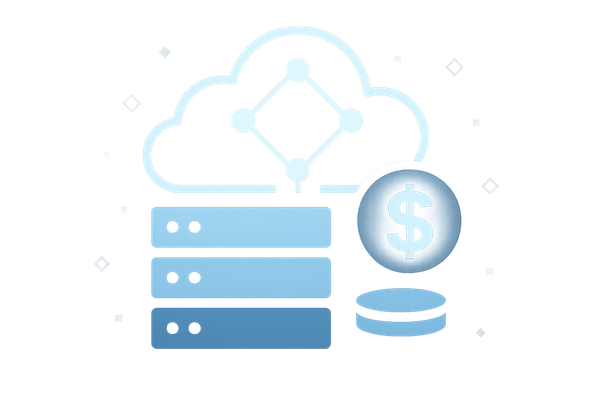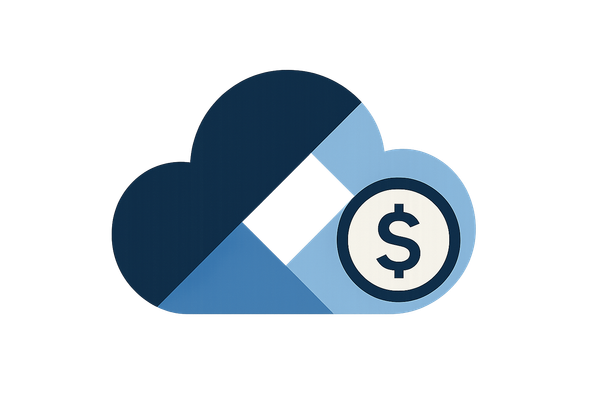Top AWS Services for Small Business Growth in 2025
Explore how AWS services can help UK small businesses enhance efficiency, reduce costs, and drive innovation in 2025.
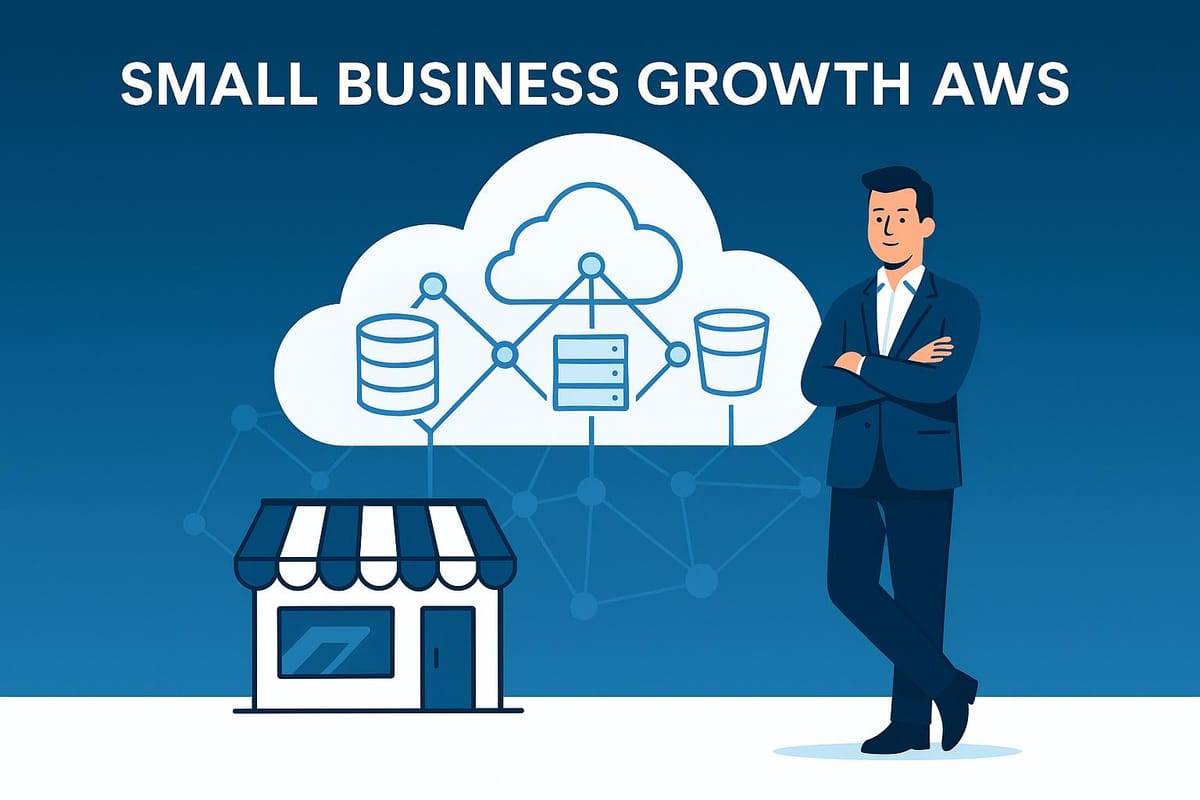
AWS is helping UK small businesses grow in 2025 through cloud computing services that cut costs, improve efficiency, and drive innovation.
Key highlights:
- AWS Lambda: Pay-as-you-go serverless computing, saving costs by scaling automatically and charging only for the compute time used.
- Amazon RDS: Simplifies database management with automated backups, scaling, and security for structured data needs.
- AWS Cost Explorer: Tracks and forecasts cloud expenses to manage budgets effectively.
- Amazon S3: Flexible and secure storage with tiered pricing for different data access needs.
- AWS Elastic Beanstalk: Simplifies application deployment by automating infrastructure tasks.
- AWS Digital Innovation Programme: Provides UK-specific resources like workshops, credits, and expert guidance to accelerate cloud adoption.
Quick Comparison
| Service | Key Feature | Cost Efficiency | Best For |
|---|---|---|---|
| AWS Lambda | Serverless computing | Pay only for compute time | Event-driven tasks |
| Amazon RDS | Managed database service | Scales automatically, free tier available | Structured data management |
| AWS Cost Explorer | Budget tracking and forecasting | Free tool, detailed cost insights | Budget and cost management |
| Amazon S3 | Tiered storage options | Intelligent-Tiering saves costs | File storage and backups |
| Elastic Beanstalk | Automated app deployment | Scales based on traffic, free tier available | Application hosting |
AWS’s tools and programmes empower small UK businesses to reduce IT costs, improve productivity, and compete globally. Explore these services to optimise your operations and drive growth in 2025.
AWS For Small Business - How Small Businesses Can Use ...
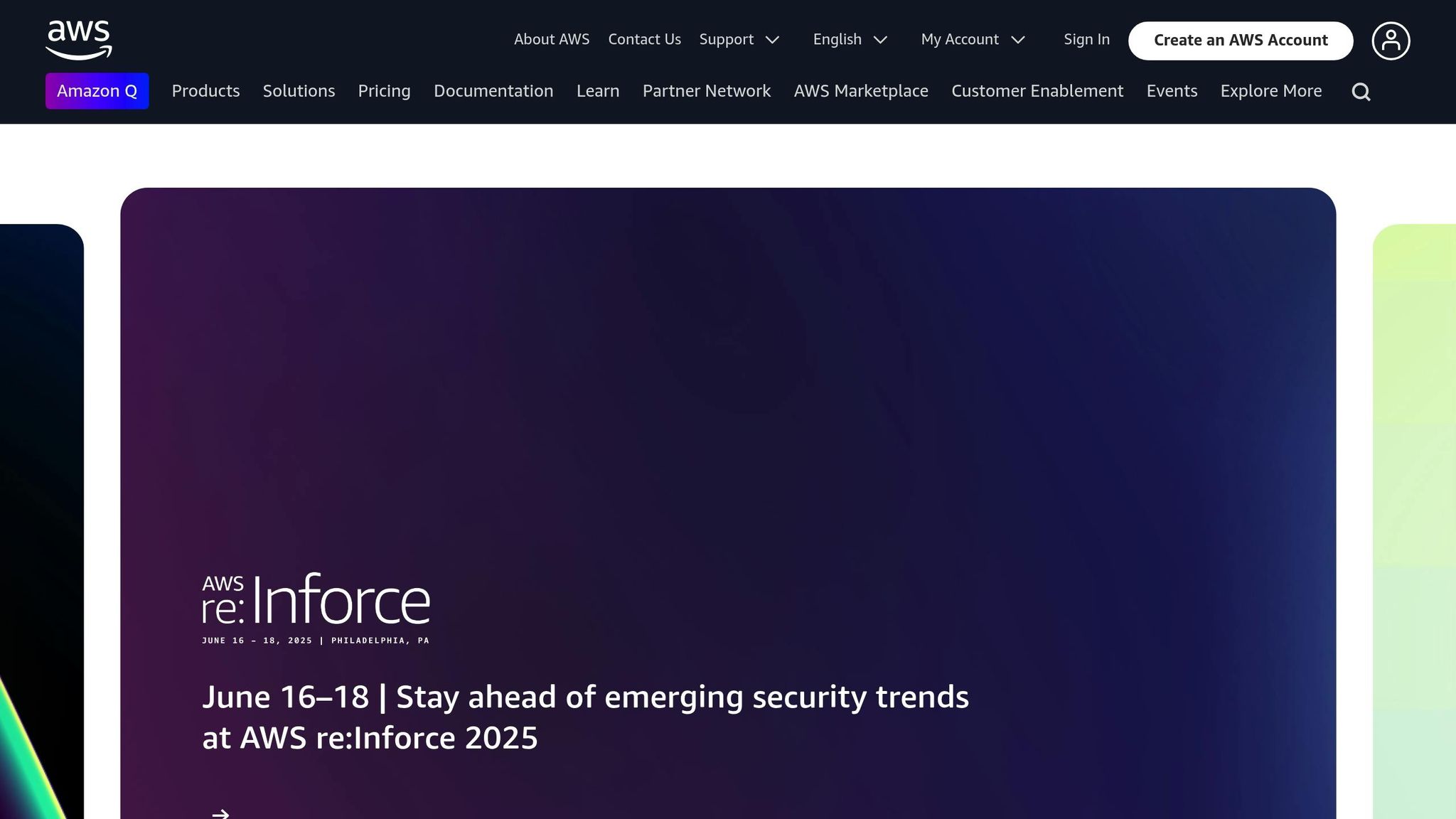
1. AWS Lambda: Serverless Computing
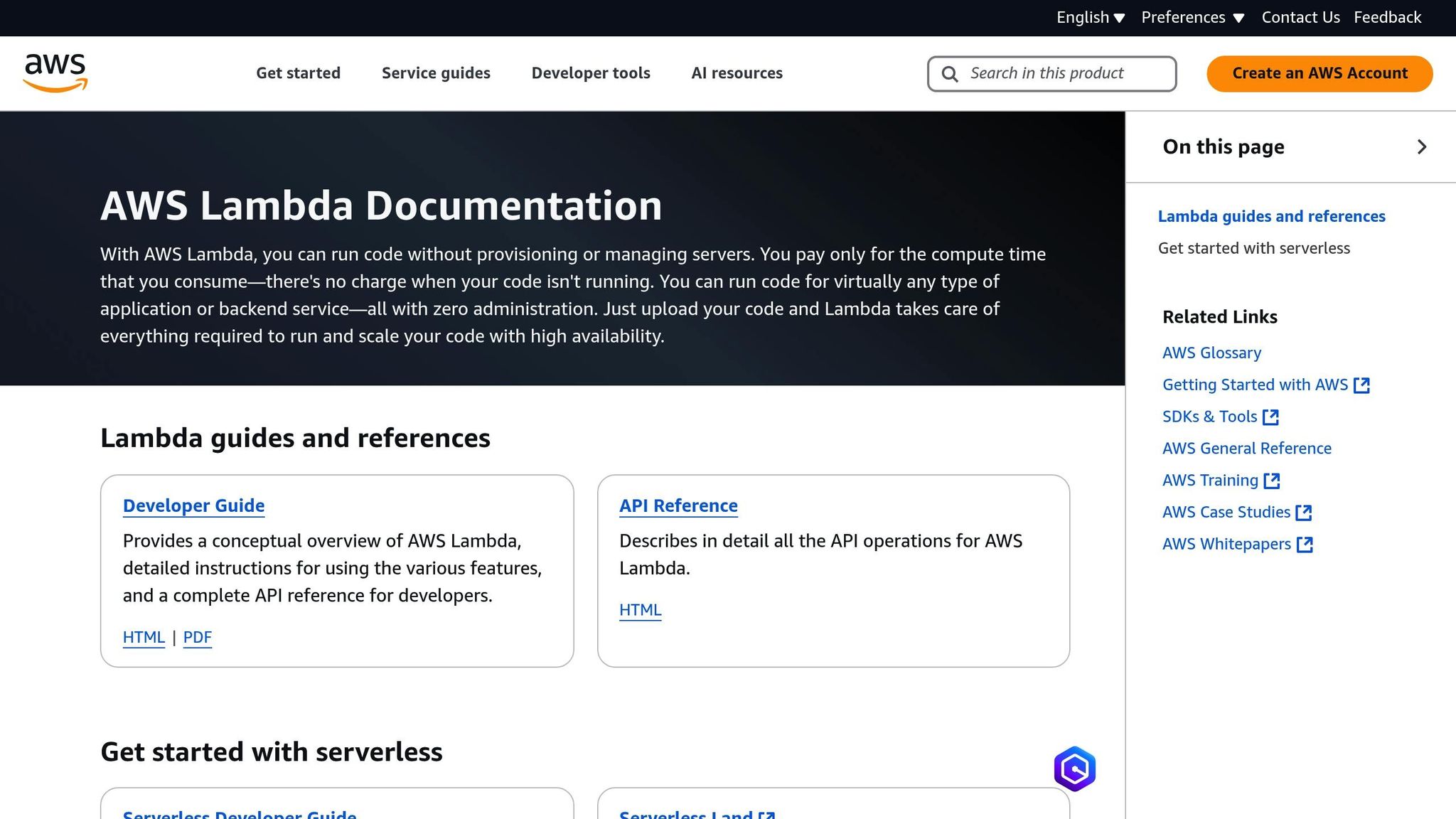
AWS Lambda offers small businesses a flexible and cost-efficient way to handle their computing needs. By removing the need to manage servers, it allows companies to focus on growth rather than infrastructure.
With its pay-as-you-go model, you’re only charged for the compute time you use - measured in milliseconds. This means no costs for idle resources. For instance, in the UK, pricing starts at approximately £0.16 per million requests.
Lambda automatically scales to handle demand, supporting up to 1,000 concurrent executions per function every 10 seconds.
Tips for Cost Efficiency with AWS Lambda
-
Memory Allocation
Begin with the lowest memory setting and adjust based on performance testing to keep costs in check. -
Processor Choice
Opt for ARM-based Graviton2 processors, which can offer up to 34% better price performance compared to x86 processors. -
Storage Management
Allocate only the ephemeral storage you need, priced at about £0.000000025 per GB-second.
For example, a mobile app backend handling three million requests monthly, with an average execution time of 120 ms and 1,536 MB memory on an x86 processor, might cost around £2.20 per month.
Seamless Integration and Added Benefits
Lambda works effortlessly with other AWS services. A great example is Infor, an enterprise application company, which uses Lambda to automate testing for over 50 applications. This setup allows them to streamline operations without requiring a dedicated IT team.
The free tier includes one million requests and 400,000 GB-seconds of compute time per month. Tools like AWS Lambda Power Tooling can help you optimise memory allocation and execution speed for better cost management. Additionally, Compute Savings Plans can save businesses up to 17% if they commit to consistent usage.
Next up: Discover how Amazon RDS can simplify database management.
2. Amazon RDS: Database Management
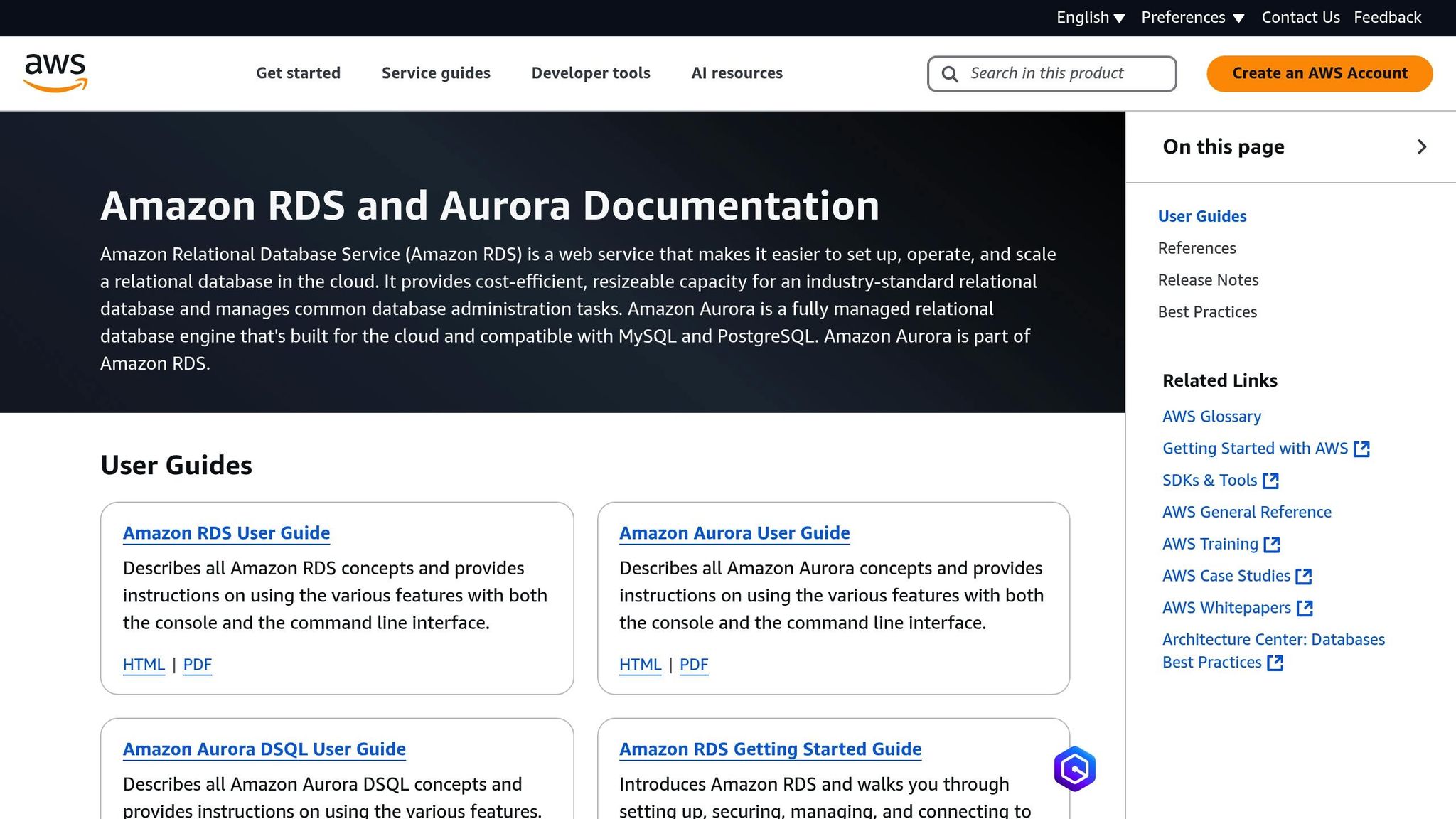
Amazon RDS streamlines database management by handling routine administrative tasks automatically. This service supports various database engines like PostgreSQL, MariaDB, MySQL, and Oracle, reducing the need for in-house management. It aligns with AWS's goal of supporting small business growth in 2025.
Automated Backup and Recovery
Amazon RDS takes care of backups automatically, storing them in Amazon S3 with a retention period of up to 35 days. With point-in-time recovery, you can restore your database to any specific moment, usually within about five minutes of the current time.
"As a managed service, Amazon Relational Database Service (Amazon RDS) takes care scaling your relational database so your database can keep up with the increasing demands of your applications." – AWS Database Blog
Flexible Scaling Options
RDS provides two main ways to scale your database:
| Type | Best For | Considerations |
|---|---|---|
| Vertical | Write-heavy tasks | Boosts instance resources like CPU, memory, and storage |
| Horizontal | Read-heavy tasks | Spreads workloads across multiple instances |
The AWS Free Tier offers 20GB of storage and 20GB for backups, making it a great option for newcomers. As your requirements increase, you can adjust resources without disrupting your service.
Backup Windows and Regional Settings
In the London region, businesses can set a 30-minute window for automated backups between 22:00 and 06:00 UTC. During this time, I/O operations may briefly pause while backups are created.
Enhanced Security and Sharing
Amazon RDS strengthens database security with features like:
- Automated patching to keep security measures current
- Secure backup storage via Amazon S3
- Cross-region snapshot copying for disaster recovery
- Snapshot sharing across AWS accounts
These security measures integrate well with its performance management tools.
Tips for Better Performance
- Monitor Metrics: Use Amazon CloudWatch to track performance and guide scaling decisions.
- Manage Connections: Deploy RDS Proxy to manage connection pools and reduce stress on your database.
- Plan Scaling: Use historical data to optimise costs while maintaining performance.
These tools and features allow businesses to concentrate on growth rather than database management, all while enjoying high levels of security and reliability.
3. AWS Cost Explorer: Budget Control
Managing budgets effectively is key to keeping your business scalable and cloud spending in check. AWS Cost Explorer is a tool designed to help small businesses track, understand, and predict their cloud expenses.
Analysing Costs in Detail
Cost Explorer offers insights into spending patterns across various timeframes and levels of detail:
| Time Range | Granularity | Key Insights |
|---|---|---|
| Past 13 months | Monthly/Daily | Historical trends and patterns |
| Next 12 months | Monthly | Forecasting and planning costs |
| Past 14 days | Hourly | Detailed usage analysis |
Accurate Forecasting Tools
With machine learning, Cost Explorer provides precise cost predictions. These forecasts can help businesses:
- Create budgets based on past spending trends
- Spot areas where costs might exceed expectations
- Allocate resources more effectively
"Forecasting is an essential part of staying on top of your cloud costs and usage, and becomes even more important as your business scales." - AWS Cloud Financial Management
Strategies for Reducing Costs
Cost Explorer can help pinpoint areas where you can save money. Here’s how:
- Resource Use
- Monitor compute hours, storage, and data transfer
- Focus on the top 25% of cost drivers
- Spot underused resources
- Budget Management
- Use AWS Budgets to set custom spending alerts
- Get notified when you’re nearing your budget limits
- Tag-Based Tracking
- Track costs by project, team, or application
- Manage expenses across different development environments
Advanced Monitoring Tools
Cost Explorer offers detailed insights at the resource level, supports API access for automation, and allows for custom reporting. These features make it easier to identify and act on cost-saving opportunities.
Seamless Integration with AWS Tools
Cost Explorer works well with other AWS services to enhance its functionality:
- AWS Budgets for automated cost alerts
- Amazon Q Developer for natural language queries
- AWS Compute Optimiser for resource usage recommendations
4. Amazon S3: Storage Solutions
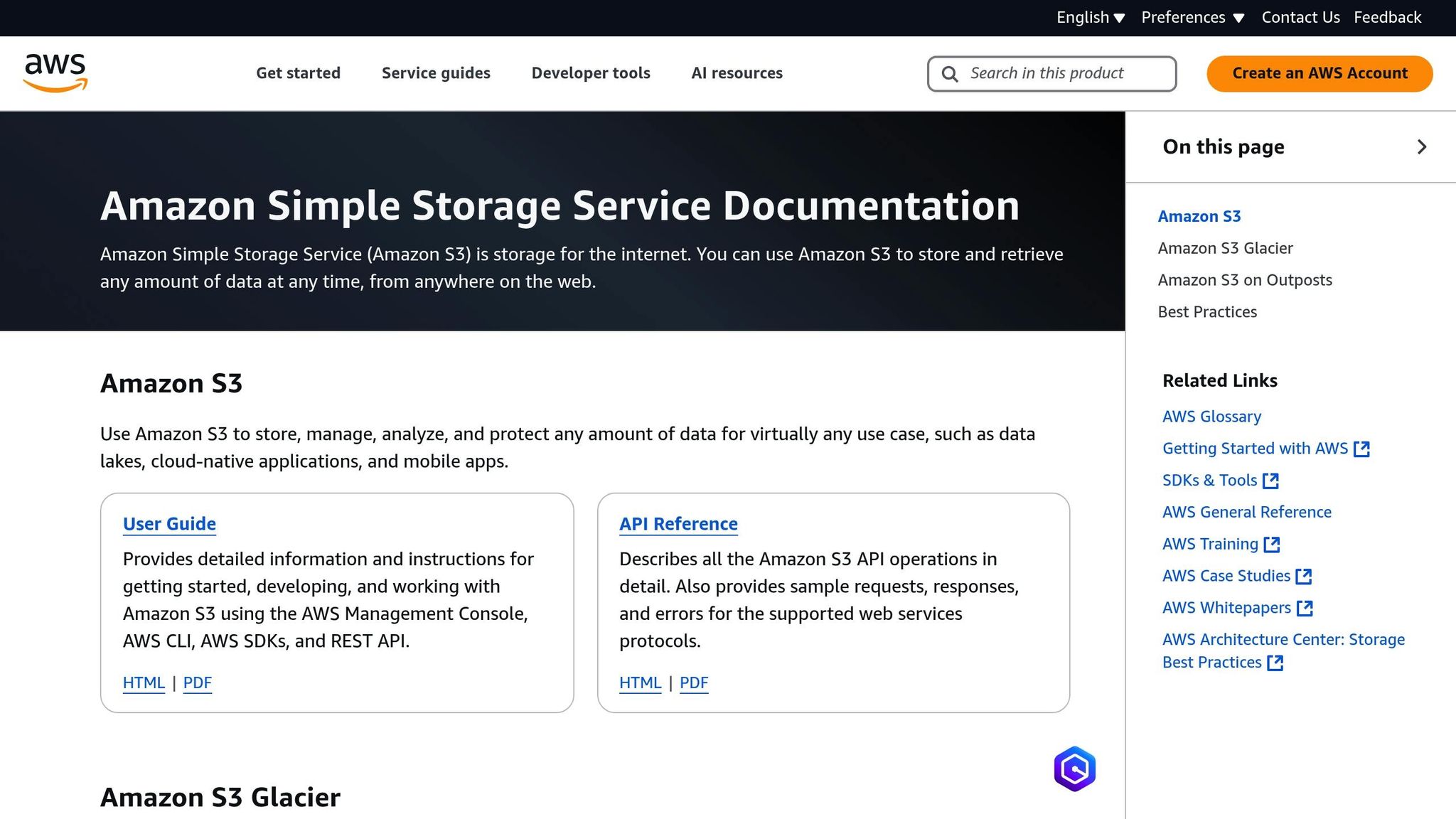
Amazon S3 offers flexible and secure storage options, making it easier for small businesses to handle their data effectively. Its range of storage classes caters to different needs and budgets.
Storage Classes Overview
Amazon S3 provides several storage classes designed for varying access patterns and cost considerations:
| Storage Class | Cost (£/GB per Month) | Best For | Minimum Storage |
|---|---|---|---|
| S3 Standard | £0.023 | Frequently accessed data | None |
| S3 Standard-IA | £0.0125 | Infrequent access, quick retrieval | 30 days |
| S3 One Zone-IA | £0.01 | Cost-sensitive, non-critical data | 30 days |
| S3 Glacier Instant Retrieval | £0.004 | Long-term archive, instant access | 90 days |
Smarter Cost Management
The S3 Intelligent-Tiering feature automatically adjusts data between storage tiers based on how often it's accessed, reducing costs without manual intervention.
"We are saving 37% annually in storage costs by using Amazon S3 Intelligent-Tiering to automatically move objects that have not been touched within 30 days to the infrequent-access tier." - Max Schultze, Lead Data Engineer at Zalando
Reliability You Can Count On
Amazon S3 ensures top-notch reliability with:
- 99.999999999% data durability across all storage classes
- 99.99% availability for S3 Standard
- Data replication across multiple availability zones
- Built-in automatic failover mechanisms
Tips for Reducing Costs
Here are some practical ways to optimise your S3 storage expenses:
- Use S3 Storage Lens to monitor access patterns.
- Set up lifecycle policies for automated data tiering.
- Compress data before storing it.
- Combine small files (under 128KB) to minimise storage overhead.
Advanced Data Management Features
Amazon S3 includes tools for managing and protecting your data, such as:
- Default bucket encryption
- Fine-grained access controls
- Versioning for tracking changes
- Storage analytics
- Lifecycle rules and object tagging
- Event notifications for real-time updates
Boosting Performance
To ensure quick and efficient data access:
- Store data in the same AWS Region as your compute resources.
- Use S3 Transfer Acceleration for remote access.
- Implement byte-range fetches for large files.
- Leverage the latest AWS SDKs for better performance.
Pomelo has reduced encryption costs by 95% using S3 Bucket Keys and anticipates 40–50% savings with S3 Glacier.
These features highlight how Amazon S3 supports small businesses by offering reliable, cost-efficient, and high-performance storage solutions.
5. AWS Elastic Beanstalk: Application Deployment
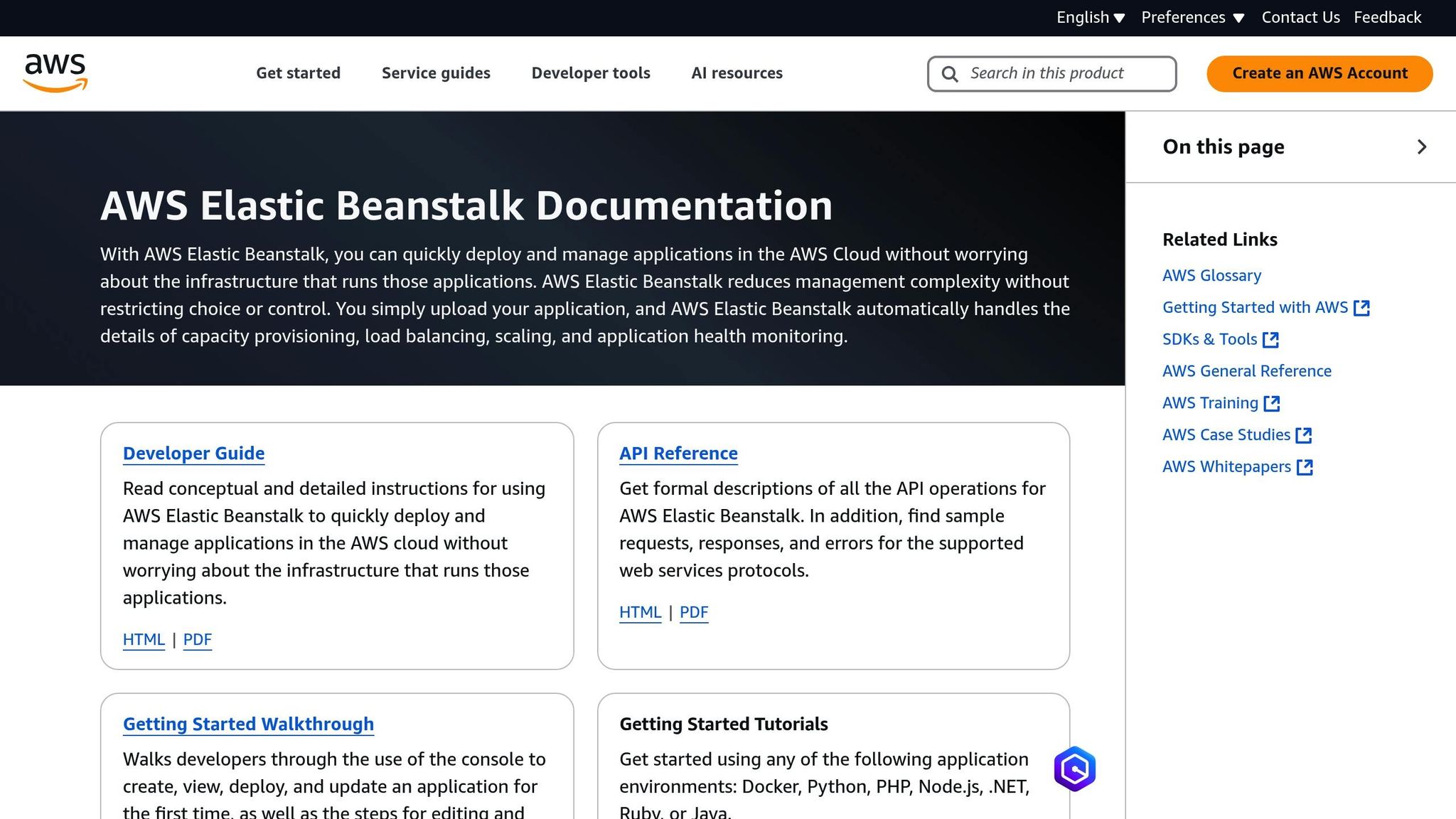
AWS Elastic Beanstalk simplifies application deployment by managing infrastructure tasks like capacity provisioning, load balancing, auto-scaling, and health monitoring. It's a time-saver for small businesses.
Deployment Options and Cost Management
Elastic Beanstalk provides several deployment strategies to suit different needs:
| Deployment Type | Ideal For | Downtime Impact |
|---|---|---|
| All at once | Development environments | Full downtime during update |
| Rolling | Production with bandwidth needs | Minimal (reduced capacity) |
| Rolling with batch | High-availability environments | None (maintains capacity) |
| Immutable | Mission-critical applications | None (zero-downtime) |
| Traffic splitting | Gradual rollouts | None (controlled testing) |
These options let you balance deployment needs with cost and downtime considerations.
Cost-Saving Tips
Environment Management
- Switch load-balanced environments to single-instance setups during quiet hours.
- Scale instance numbers up or down based on traffic trends.
- Use AWS CLI to automate shutting down test environments at night.
Built-in Features
Automated Infrastructure
Elastic Beanstalk handles:
- Resource provisioning and configuration
- OS updates and application stack upgrades
- Health checks and metrics collection
- Multi-zone setups for improved resilience
Platform Compatibility
It supports various programming languages and frameworks, including:
- Java, .NET, and .NET Core
- PHP, Node.js, and Python
- Ruby and Go
- Docker containers
Performance Tips
Switch to ARM-based Graviton processors for better price-performance compared to x86 instances.
Efficient Resource Use
- Separate dependent services and use Spot Instances to save money while maintaining capacity.
- Set auto-scaling rules based on actual usage to optimise resources.
These measures, combined with effective monitoring, help you fine-tune your application performance.
Monitoring and Maintenance
Elastic Beanstalk offers tracking for:
- Deployment success rates
- Environment health
- Resource performance
- Application logs
- Infrastructure status
This real-time monitoring ensures your applications run smoothly and efficiently.
6. AWS Digital Innovation Programme: UK Support
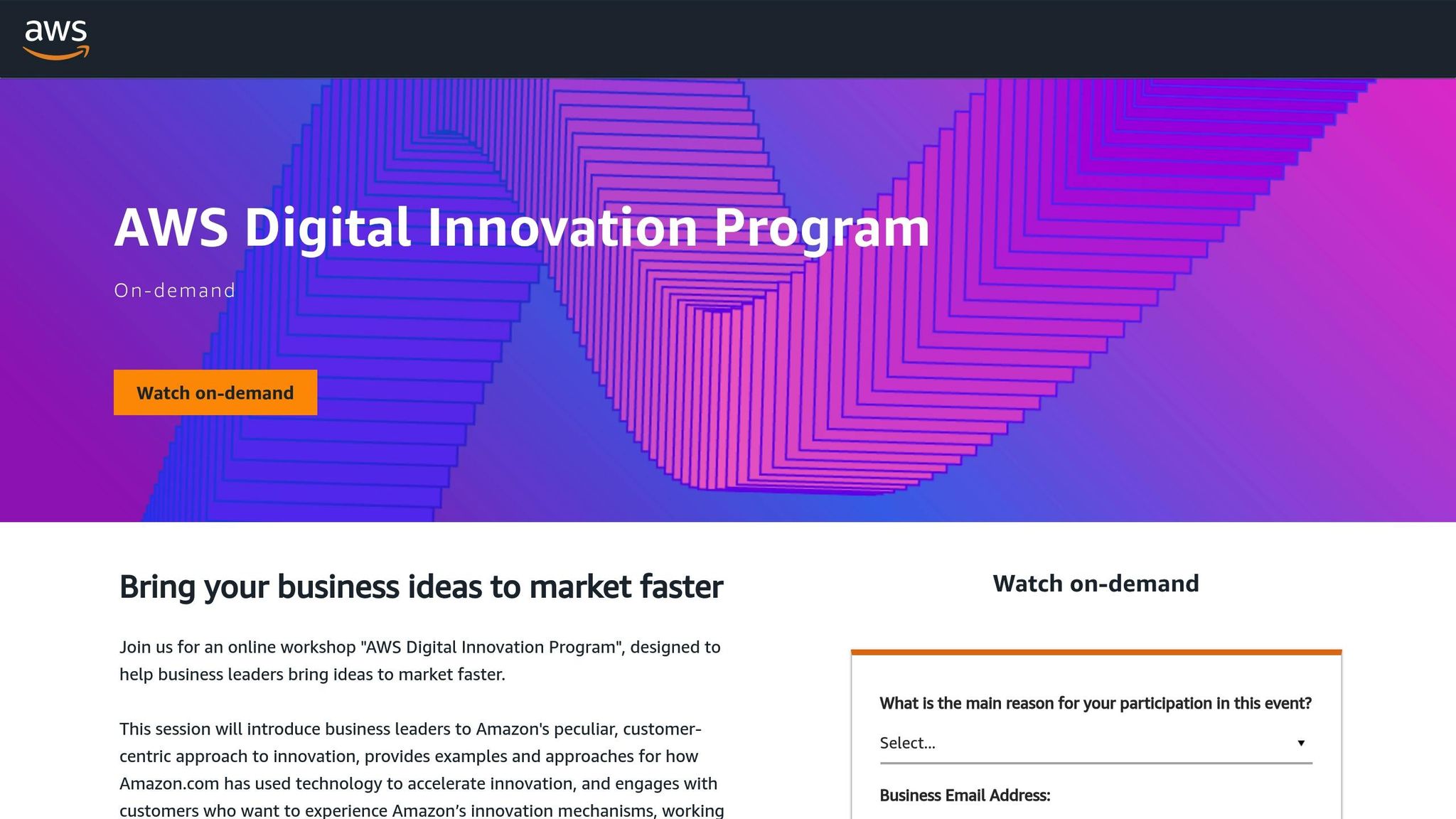
Expanding on AWS's scalable and cost-efficient solutions, the AWS Digital Innovation Programme is designed to help UK SMBs enhance their operations and embrace cloud technology effectively.
This programme addresses the specific challenges faced by British SMBs in 2025, offering tailored support to encourage growth and innovation.
Programme Benefits and Resources
The programme offers a range of resources aimed at helping businesses adopt cloud technologies:
| Resource Type | Key Features | Business Impact |
|---|---|---|
| Hands-on Workshops | Practical cloud technology skills, business architecture evaluation | Immediate, actionable learning |
| Technical Consultations | Free 1:1 expert guidance, AWS tool implementation | Customised solutions for businesses |
| Credit Support | £235 to £785 through AWS Rapid Ramp | Reduced costs for testing and deployment |
| Digital Skills Training | Focus on customer-centric practices and the 'working backwards' methodology | Improved product development |
These resources, combined with AWS's technical tools, provide a strong foundation for SMB growth and regional economic development.
Regional Impact and Growth Potential
Research shows that if cloud adoption rates in the North East matched those in London, regional productivity and wages could increase by 2.6%. This highlights the programme's potential to drive economic progress across various regions in the UK.
Success Stories and Implementation
RPAIR, a jewellery and watch repair marketplace based in the UK, is a great example of the programme's impact. With AWS's guidance, they refined their business approach. Michael Jakobson, RPAIR's Founder and CEO, shared:
"AWS encouraged us to shift from a goal to develop fast with lots of different solutions for customers, to a much narrower focus that we could really excel at. As a result, we challenged ourselves to identify what exact services our customers really needed. Then we worked our way backwards from there."
Practical Application Framework
The programme targets three main areas of transformation:
- Digital Innovation Strategy
- Developing customer-focused products
- Streamlining business processes
- Integrating cloud technologies
- Technical Skills Development
- Utilising AWS tools and services
- Evaluating business architecture
- Creating effective working models
- Decision Support
- Assessing 'build vs buy' technology options
- Refining product development methods
- Analysing market opportunities
Expert Guidance
Rob Hodges, Digital Innovation Lead at AWS, highlighted the programme's practical approach:
"We are excited to share Amazon's 'working backwards' approach to innovation with hundreds of SMBs across the UK, and help them to apply it to their businesses. We want to give businesses of all sizes the same opportunities as large enterprises to embrace the technology, mindset, and methodology to succeed."
This hands-on focus has been especially beneficial for companies like CitNOW Group, showcasing how theoretical knowledge can lead to tangible business improvements, particularly when making technology investment decisions.
Additional Support Services
AWS also offers a variety of community resources to complement the programme. These include events, workshops, and online training modules, ensuring businesses have ongoing support for their digital transformation journey.
Service Comparison Guide
Understanding the costs and technical needs of various AWS services is essential for small businesses shaping their cloud strategies. This guide summarises key details to help businesses choose the right AWS services for their growth plans and make informed decisions about implementation.
Core Service Comparison
| Service Feature | AWS Lambda | Amazon RDS | Amazon S3 | AWS Cost Explorer |
|---|---|---|---|---|
| Base Pricing | £0.16/million requests | From £0.092/GB-month | From £0.018/GB-month | Free tool |
| Additional Costs | Compute time: £0.0000166/GB-second | Backup storage: £0.076/GB-month | Data transfer: Variable | – |
| Free Tier | 1 million requests/month | Limited hours/month | 5GB storage | Included |
| Technical Expertise | Moderate to High | Moderate | Low to Moderate | Low |
| Best For | Event-driven tasks | Structured data | File storage | Cost management |
Cost-Efficiency Analysis
AWS Lambda is particularly cost-effective for workloads that are sporadic. Prakash Pilley, CEO of Deployflow, highlights this:
"Cloud cost management is one of the most pressing concerns for SMBs. We work with businesses to forecast and optimise their AWS spend and implement best practices for keeping costs under control".
Storage and Database Considerations
Amazon S3 provides tiered storage options, with costs depending on how often data is accessed and how long it is stored. For Amazon RDS, pricing varies based on factors like instance type, database engine, deployment mode, and storage volume.
Implementation Requirements
Thomas Radosh, CTO at Deployflow, stresses the importance of a step-by-step migration approach to avoid disruptions:
"The key to minimising disruption during cloud transformation is a careful, step-by-step approach. This ensures that businesses can migrate without affecting day-to-day operations".
Cost Management Tips
To manage costs effectively across AWS services, consider these strategies:
- Reserved Instances: Save on RDS by committing to 1–3 year terms.
- S3 Lifecycle Policies: Automate data movement between storage tiers to lower costs.
- Optimise Lambda Functions: Adjust memory allocation to improve cost efficiency.
Performance Metrics
A recent study found that 67% of executives struggle to extract value from their data. To address this, focus on:
- Monitoring resource usage.
- Setting up auto-scaling to handle demand changes.
- Regularly reviewing costs using AWS Cost Explorer.
- Using AWS Savings Plans for consistent workloads.
Advanced Cost Considerations
| Consideration | Impact on Costs | Recommendation |
|---|---|---|
| Data Transfer | Can increase expenses | Use the same AWS Region where possible. |
| Backup Strategy | Affects storage costs | Implement lifecycle policies to optimise storage. |
| Performance Needs | Impacts instance sizing | Start with smaller instances and scale up as needed. |
| Availability Requirements | Multi-AZ deployment costs | Balance redundancy with your budget. |
Next Steps
Now that you've looked into key AWS services that can drive SMB growth, it's time to turn those insights into actionable steps.
Initial Setup and Training
Start with AWS SkillBuilder, which offers over 500 courses to help you get up to speed. Take advantage of the AWS Free Tier, which gives you 12 months of access to more than 100 products. This lets you try out services like Lambda and RDS without upfront costs.
UK-Specific Support Channels
AWS provides several UK-based resources to help you along the way:
| Support Channel | Purpose | Key Benefit |
|---|---|---|
| AWS Experience London | Technical training and networking | Direct access to AWS specialists |
| AWS Connected Community | Peer learning and knowledge sharing | Industry-specific insights |
| AWS Partner Network | Implementation guidance | Local expertise |
These resources are designed to complement your training and offer localised support as you move forward.
Funding and Resources
If you're a UK startup, check out funding options tailored to your needs. The AWS Activate Founders programme offers up to £80,000 in AWS credits, along with technical support and infrastructure templates.
"The AWS team has shown a real ability and willingness to help us solve problems for our customers. That's been key to our business development efforts." - ENSEK
Cost-Efficient Implementation
Here are some ways to keep your AWS usage cost-effective:
1. Resource Management: Use development environments that can be paused when not in use, cutting costs by up to 75%.
2. Service Selection: Deploy applications on AWS Graviton-powered instances for better price-performance.
3. Operational Efficiency: Use Amazon Aurora on RDS to avoid costly database licensing fees and enable Auto Scaling to adjust resources based on demand.
Expert Guidance
For tailored advice, connect with the AWS UK and Ireland team. They can help with:
- Migration planning and architecture reviews
- Cost optimisation workshops
- Security assessments
For quick assistance, use AWS's virtual assistant or live chat for technical queries.
Monitoring Progress
Track your AWS usage with AWS Cost Explorer. Monthly reviews can help you optimise your services, ensuring your investment delivers results while staying cost-effective.
FAQs
How can small businesses choose the right AWS services to meet their needs and stay within budget?
To choose the most suitable AWS services for your small business, start by identifying your immediate priorities, such as storage, automation, or database management. AWS offers a wide range of tools tailored to different needs, including Amazon S3 for scalable storage, AWS Lambda for automation, and Amazon RDS for efficient database management.
To manage costs effectively, use tools like AWS Cost Explorer to monitor your spending and optimise resource usage. Consider pricing models like Spot Instances or Reserved Instances to reduce expenses. If you're unsure, seeking advice from AWS-certified experts or partners can help you implement solutions tailored to your business goals.
How can a small business start using AWS services effectively?
To get started with AWS, small businesses should first create an AWS account, which includes access to a free tier for the first 12 months. It's essential to set up IAM users for team members to ensure security and manage access permissions. Additionally, enabling billing alerts will help monitor costs and avoid unexpected charges.
For domain management, consider registering a domain through Amazon Route 53, which simplifies setup and integration with other AWS services. Small businesses can also explore the AWS Partner Network (APN) to connect with certified experts who can assist in planning and implementing tailored solutions. AWS starter kits are another great resource, offering pre-built solutions to address common business needs while helping you get familiar with AWS tools and best practices.
By starting small and focusing on key services, businesses can gradually scale their AWS usage to support growth in a cost-effective and efficient way.
How can the AWS Digital Innovation Programme help small businesses in the UK adopt cloud technology effectively?
The AWS Digital Innovation Programme is designed to help small and medium-sized businesses in the UK harness the power of cloud technology to drive growth and efficiency. It offers on-demand sessions and tailored guidance to educate business leaders on implementing cloud solutions effectively.
Through this programme, SMBs can gain practical insights into streamlining operations, improving scalability, and reducing costs. By focusing on real-world challenges faced by small businesses, AWS provides tools and strategies to support digital transformation and long-term success in a competitive market.

